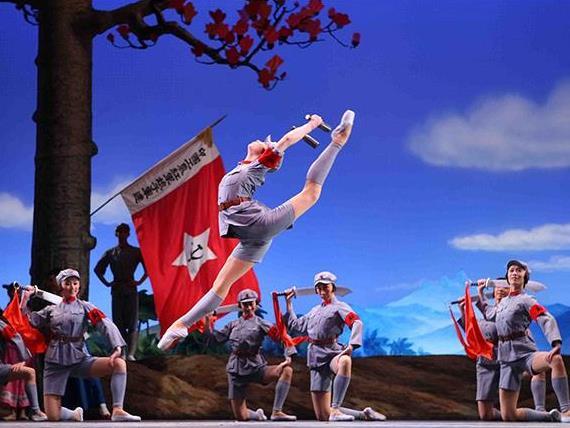The Red Detachment of Women image via Asia TOPA.
It’s not often you can call a well-known ballet ‘feminist’ but the story of a young woman striving to overcome the systemic corruption and injustice of the society she has been born into with no romantic sub-plot passes the Bechdel test with flying colours. Hollywood could perhaps learn a thing or two from this 1964 stage adaptation of Liang Xin’s true story of Hainan Island’s peasant uprising. More than fifty years later, this seminal piece of modern China’s cultural mythology has lost none of its potency. In this most recent production, the National Ballet of China has brought a powerful iteration of The Red Detachment of Women to Asia TOPA, which holds nothing back in pressing home the story’s moral.
At the story’s centre is Qionghua, exquisitely portrayed by Zhang Jian. She begins as a captive of the cruel local landlord Nan Batian but escapes and joins the local revolutionary cadres. She finds empowerment and rises quickly through the ranks but in a moment of selfishness and caprice in battle she allows Nan Batian to escape. With the help of brave and noble commander, Hong Changqing, she learns the importance of discipline and putting collective goals ahead of individualistic pursuits. In the final climactic battle she rises above her selfish desire for revenge and leads her comrades to victory before serving justice on Nan Batian and killing him as he flees.
It’s unambiguously propagandist in its intent, its characters are somewhat one-dimensional and there are moments so over the top, a rainbow said to appear over the revolutionaries victory for example, that they almost absurd. But it would be supremely hypocritical to dismiss it on the grounds of messaging. Liberal ideology is so strongly entrenched in the so-called West that the core narrative no longer even needs to be hinted at in the plethora of film, TV and stage productions that operate blindly within its ideological grounds.
The Red Detachment of Women is a fascinating piece of art specifically because it is so enmeshed in the historical epoch that birthed it and agree or not with the politics it espouses one cannot deny the care and skill with which this latest production has been crafted. The villains are dour-looking and lit in dim, decaying colours while the heroes are pure and heroic, lit brightly in vivid technicolour. The score is similarly partisan and iconography front and centre. There is no attempt or need to weave in subliminal messaging because it is promulgated proudly. It would have been foolhardy and ineffective to present it any other way.
The National Ballet of China and Orchestra Victoria have done a marvellous job of bringing this ballet to life and Zhang Jian, Lu Na and Zhou Zhaohui are impeccable in the principal roles. There are issues to take with the plot and characters but in the context of national myth making, the subtleties can come from the commentators. The Red Detachment of Women is true to itself and an enthralling ballet that deservedly holds its place as both iconic and controversial.
Rating: 4 Stars our 5
The Red Detachment of Women
Arts Centre Melbourne
15 – 18 February
The National Ballet of China in association with The Australian Ballet and Orchestra Victoria
Choreographed by Li Chengxiang, Jiang Zuhui and Wang Xixian Music by Du Mingxin, Wu Zuqiang, Wang Yanqiao, Shi Wanchun and Dai Hongcheng





